Wednesday, November 29, 2006
SMARTPAK and LIFE DATA LABS Partner To Make FARRIER'S FORMULA Available in SMARTPAKS
(provided by press release simultaneously from our friends at Smart Pak and Life Data Labs)
CHEROKEE, AL and PLYMOUTH, MA (November 29, 2006)-- Life Data Labs and SmartPak Equine announced today that they have entered into a partnership to make Farrier's Formula available in SmartPaks. Farrier's Formula is the original hoof supplement, and has been shown effective in university studies as well as Life Data's own extensive research.
"Farrier's Formula has been our most widely requested hoof product, and we are delighted to be able to offer it to our customers," said Paal Gisholt, SmartPak's President and CEO. "In getting to know the Life Data team, I have had the opportunity to see their commitment to making a quality product first hand, and their care and attention to product quality is exceptional."
"We are happy to be making Farrier's Formula available to the many barns and individuals that have adopted the SmartPak feeding system," said Brian Jones, an executive with Life Data Labs.
"We took advantage of the extra protection offered by the SmartPak delivery system to create a special concentrated version of Farrier's Formula that contains the same level of nutrients and benefits of the non-concentrated version," he continued.
"Furthermore, our utilization of vacuum-packaging under nitrogen for delivery to SmartPak allows us to guarantee high levels of Omega 3 and Omega 6 fatty acids, along with Vitamin C, making this concentrate an excellent choice for skin and coat as well as hoof health," Jones concluded.
Under the partnership, the companies agreed to a limited exclusivity. SmartPak has agreed not to offer hoof supplements that exactly copy Farrier's Formula and Life Data Labs has agreed that SmartPak will be the exclusive provider of Farrier's Formula in daily doses custom-packed for an individual horse. Other terms of the partnership were not disclosed.
Note: SmartPak and Life Data Labs are two of the companies that generously support Hoofcare & Lameness Journal with advertising; Life Data also sponsored one of our "Hoofcare@Saratoga" evening lectures last year at Saratoga. SmartPak recently opened their first retail store here in the Boston area, and I have had the pleasure of shopping there. We are very pleased to see these two companies working together. Congratulations to both! We look forward to seeing them at the AAEP Convention next week.
Dr. Scott Morrison May Examine Barbaro's Foundered Foot, Report Says
Here's the link to the story, which has not been verified by Dr. Morrison:
http://www.delawareonline.com/apps/pbcs.dll/article?Date=20061129&Category=SPORTS09&ArtNo=61129051&SectionCat=&Template=printart
Stay tuned for more developments. Dr. Morrison will be a guest at the Hoofcare & Lameness booth at the American Association of Equine Practitioners Convention in San Antonio, Texas on Sunday, December 3rd and Monday, December 4th at 5:oo pm each day. We hope to see Dr. Anderson there too.
Tuesday, November 28, 2006
Ferrie Brothers DVD Reveals Family Secrets of Shoemaking and Clydesdale Hoof Care

Two of the world's most accomplished farriers are Allan and Jim Ferrie of Ayrshire, Scotland. Both are Fellows of the Worshipful Company of Farriers, top international competitors, and first-class educators. But first and foremost, they are Scotsmen, and as such they are impeccable ambassadors for the craft of farriery in their country. Plus they look great in those kilts.
So impressed with these two men am I that within minutes of receiving a new DVD produced by them, I was searching for a DVD player. I usually am not anxious to watch tapes of shoemaking demonstrations or competitions, but I knew this would be different and I was correct.
The DVD is a superb revelation on how and why the traditional Scottish heavy horse is shod the way it has been for so many years. The Ferries dissect the construction of the shoes into minute details (of both front and hind shoes) and relate the details of the shoe to the foot of the horse; you watch Allan forge each inch of the shoe, while Jim explains what Allan is doing, which is shown in slow motion. Sparks stop in mid-air.
Admittedly, it looks all too easy, as if the steel in the shoe wanted to follow the focused nudge of the hammer's head. Every hammer blow has a distinct purpose; Allan's technique is a model of efficiency and artistry.
The second half of the DVD is about the application of the shoe and the foot of the Clydesdale.
The good news is that you too can stay up too late looking at feathery Clydesdale feet. The Ferrie Brothers' DVD will be sold by Hoofcare & Lameness, beginning December 1, 2006. Cost is at an introductory price of $49 plus $5 post to US addresses ($10 to the rest of the world). The price will be subject to change without notice because of the change in value of the dollar against the pound.
To order, email dvd@hoofcare.com or call 978 281 3222. Mail checks to Hoofcare DVD, PO Box 6600, Gloucester MA 01930. Please note that the office will be closed from December 1 to December 6 while we are at the AAEP convention.
Monday Updates: AAEP Convention Speaker Changes
Sadly, we heard from another of our editors, Dr. Jean-Marie Denoix of France, that he will not be able to attend the convention. He will celebrate the Feast of St Eloi (patron saint of farriers and a national holiday in France) at home in Normandy on December 7.
Dr. O'Grady also mentioned that the American Farrier's Association has appointed three farriers to the AAEP's liaison committee for terms beginning in 2007. They are John Suttle of California, Michael Wildenstein (see above), and Dan White, resident farrier at Iowa State University College of Veterinary Medicine.
Easyboot Epic Named as Product of the Year!
The Horse-Journal has named the Easyboot Epic one of the their Top 10 Products of the Year. "At the end of each year, we look back on the products that we've used in our test barns," say the editors of The Horse Journal. "
We consider what various manufacturers have brought to the market and how those products make taking care of our horses easier. We select items that have improved our ability to optimize health care especially in ways that we can undertake ourselves. We look for products that keep safety in mind, work economically and/or simply solve problems. Above all, we look for products that make the biggest difference in our barns."
"EasyCare took their well-known Easyboot and made it even better, adding a gaiter to the top. This addition makes the boot stay in place better than ever. Horses easily became accustomed to wearing the boot, and it stayed secure. Lightweight and flexible."
Sunday, November 26, 2006
Roadblocks Can't Stop Kazakhstan's Horse Van: Borat Behind the Wheel?
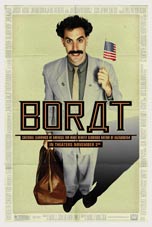 Poor Kazakhstan. Life is imitating art again. (If you can call this film "art"?)
Poor Kazakhstan. Life is imitating art again. (If you can call this film "art"?)The Asian Equestrian Games are starting December 1 in Doha, Qatar...so where are the Kazak team's horses? This sounds like a Saturday Night Live skit takeoff on the film "Borat", as reported on the Internet.
The cost to fly the horses was not in the budget, and there were issues about visas and quarantines, so they opted to drive...and it took 13 days (six days longer than expected) from their training camp in Germany.
First they drove through Austria to Italy and then by ferry to Greece. Then overland to Turkey (where they had border problems) then on across that huge country to Syria (and more border problems), Jordan, and then across Saudi Arabia to Qatar, a distance of 6700 km.
I would have loved to ride along and written a blog of their day-by-day adventures. But one must wonder: What was the condition of those horses when they stumbled off that truck into the blazing Qatar sun? Let's hope the van was air-conditioned.
The Asian Games are fascinating, and I wish there was more media coverage here in the USA; we might all learn something about how the rest of the world lives (and rides). For instance, equestrian sports are one of the very few events in which women from strict Islamic nations are allowed to compete. Why? Because their bodies are covered, head to toe. Think about it. Iran's women's karate team is boycotting the Games because the rules won't allow them to wear their headscarves in competition.
I'll be cheering for Kazakhstan. There's a good summary of this story on the English-language Chinese site. The Chinese are pumped up for the Asian Games in preparation for the 2008 Olympics, although the equestrian events will be held in hot, steamy Hong Kong instead of Beijing...and they may also be monitoring the equestrian transport issue as more and more countries in Asia are competing at the FEI level and must figure out how to get their horses to Hong Kong (and have them be healthy enough to compete).
Hopefully the Kazaks won't have to drive there...just think if they received some small portion of the profits from that movie!
Saturday, November 25, 2006
AAEP Convention: Late Announcements
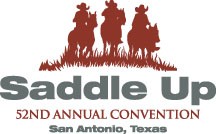 Thanks to Dr. Steve O'Grady for checking in on Friday and providing some new information for farriers and veterinarians (and anyone else) attending the American Association of Equine Practitioners Convention in San Antonio December 3-6.
Thanks to Dr. Steve O'Grady for checking in on Friday and providing some new information for farriers and veterinarians (and anyone else) attending the American Association of Equine Practitioners Convention in San Antonio December 3-6.Here are some updates from Dr. O'Grady and from Hoofcare & Lameness Journal:
1. On-site registration will offer a one-day registration fee for $175 to anyone who wants to attend, for instance, Monday or Tuesday, and not the entire convention. This fee includes lunch and the trade show as well as all lectures and table topics.
1a. This just in from AAEP trade show manager Debbie Miles: "If someone wants to attend just the trade show, it is $25.00 a day. This will not allow them to work (in a) booth or attend any scientific sessions, just allows them to visit the trade show."
2. Farriers who register should identify themselves as farriers so a tally can be kept. Farriers are welcome (and encouraged) to attend any and all lectures offered at the convention in addition to the farrier-specific program on Tuesday morning.
3. Hoofcare & Lameness is publishing a "Survival Guide" to the convention specifically for those interested in the hoof programs. It will list all events, lectures, table topics, etc. with relevance to working with hooves. (Did you know there is a special program on endocrine problems, i.e. Cushings syndrome and the relation to obesity?) With a little luck, this will be posted on hoofcare.com for you to download by Thursday of this week.
4. Dr. Tracy Turner has replaced Dr. Andy Parks at one of the table topics discussions, according to Dr. O'Grady.
5. Hotel rooms are still available; the online rates for Homewood Suites and the Omni are both around $130 and both are near the convention center. All the "official" hotels (Marriott, Menger, etc.) are sold out as is the new LaQuinta. There are some very inexpensive hotels on the outskirts of San Antonio if you have a car.
6. Hoofcare & Lameness will have hourly special guests at our booth (#354), including Dr. Chris Pollitt, California farrier John Suttle, Bob Pethick, Michael Wildenstein, etc. We will provide bar stools and a table to lean on, plus maybe some napkins to draw on so you will feel right at home. We will also have free copies of the Animal Health Foundation's DVD, featuring Chris Pollitt and Katy Watts. We will also have a museum display (sorry, not for sale) of plastination anatomy models (a la the "Body Worlds" museum exhibit) from Dr Christophe Von Horst of Germany.
7. Southwest still has some cheap flights to San Antonio!
8. The trade show is huge (over 300 companies) and includes many companies (Delta, Mustad, HoofJack, HorseScience, Vettec, etc.) that you would normally see at a farrier convention. And some that you wouldn't see there, but whose products or services are interesting. The American Farrier's Association will have a booth, with president Dave Ferguson in charge, according to Mike Nolan, AFA executive director, and Jack Millman, the AFA's new marketing committee chairman.
Please contact Hoofcare & Lameness if we can help you make plans!
Friday, November 24, 2006
Patrick Reilly will be New Bolton Center's New Farrier
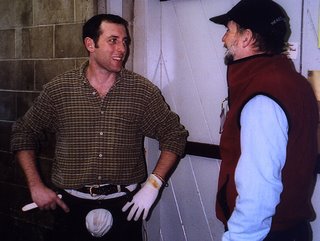
Patrick Reilly of Chester, New Hampshire will be changing his address on Monday, when he begins work as the new farrier at New Bolton Center, the site of the large animal clinics of the University of Pennsylvania's College of Veterinary Medicine.
To quote a memo from the administration: "(we) announce the appointment of Mr. Patrick (Pat) Reilly as Interim Director of the Farrier Service at New Bolton Center....thanks to Rob Sigafoos for helping to recruit Pat to New Bolton Center as we know Pat's work will compliment the excellence in the Farrier Program that has been established by Rob."
Rob's role at New Bolton is a little gray at the moment, since he is suffering from back problems but as far as I know, Rob has neither retired nor resigned, but is taking some time to recover.
Both Rob and Patrick will serve on the faculty of the 4th International Equine Conference on Laminitis and Diseases of the Foot in Palm Beach (aka "Palm Beach Laminitis") in November 2007.
Patrick has worked as consulting farrier at the New England Diagnostic Imaging Center (Myhre Equine Clinic) in Rochester, New Hampshire and also as a contract farrier for the Tufts Cummings School of Veterinary Medicine in North Grafton, Massachusetts. Until the hospital closed, he was consulting farrier at the Rochester Equine Clinic in New Hampshire.
Patrick is known for his expertise (and preference) for adhesive shoeing. I heard him say once at a conference that he had applied more than 300 pairs of glue-on shoes,primarily of the Sigafoos design, that year. He is also an early-adapter of technology, and was the farrier who taught me about Metron software. He has loaned me his laptop when mine was smoking from system overload. Patrick also has a fascination with biomechanics research; he actually reads all those charts and graphs, and has experimented with the interesting Tekscan pressure measuring system.
No word yet on whether Patrick will be working on New Bolton's most famous patient, Barbaro.
Please scroll down to posts from earlier in November or click here to read our "hail and farewell and hello again" to departing resident farrier at New Bolton, Laura Florence.
Good luck to Patrick! Get well to Rob!
Photo: Patrick Reilly (left) chats with Rob Sigafoos (right) at a recent conference. Fran Jurga photo, © Hoofcare & Lameness Journal.
To learn more about new research, products, and treatments for the horse's hooves and legs as reported to veterinarians and farriers in the award-winning "Hoofcare & Lameness Journal", go to http://www.hoofcare.com
Direct link to subscribe via secure server to Hoofcare & Lameness Journal: http://www.hoofcare.com/subscribe.html
Save on books! Visit our "fall cleaning" sale of out-of-print, used, and damaged books: http://www.hoofcarebooksale.blogspot.com
Contact Hoofcare Publishing anytime: tel 978 281 3222 fax 978 283 8775 email bloginquiry@hoofcare.com
Thursday, November 23, 2006
Pony Found with Meter-Long Hooves in Wales

The BBC has posted an RSPCA story from the UK which stimulated some discussion today. A pony stallion was found in Wales with neglected hooves, one of which was over a meter long. I wondered simultaneously at the cruelty of the owner to ignore the poor horse, but also wondered if there is a Guiness Book of World Records for the longest pony hooves? Amazingly, it doesn't sound as if the horse had laminitis. He grew quite a mane too, but doesn't look hungry.
If you take a good look at the photo, it is obviously the right front that grew to the great length that it did a spiral; the left front is growing in with much wider radius...and straight up in the air. After listening to or reading Meike Van Heel's research on asymmetric stance and foal development, this difference jumps right out at you.
Read all about this pony's rescue by the RSPCA (but not much about the hooves) at http://news.bbc.co.uk/2/hi/uk_news/wales/south_west/6177606.stm
Conformation Conundrum at the Brookfield Zoo: But Can She Trot?

What do you get if you cross a giraffe and a zebra? And what if you throw in a little moose and, um, maybe some Oldenburg warmblood genes? Chances are, it would look a lot like Sauda, the new Okapi calf born this fall at the Brookfield Zoo in Wisconsin.
A shy native of the dark forests of the Democratic Republic of Congo, the okapi makes you want to sit back for a minute this Thanksgiving day, and thank Nature for not providing too-easy answers to all the questions we have about life on earth.
Read all about Sauda and see more photos at http://www.brookfieldzoo.org/0.asp?shttplink=../pgpages/pagegen.295.aspx&nsection=2
Thursday, November 16, 2006
Three-Dimensional Race Plates for Glueing
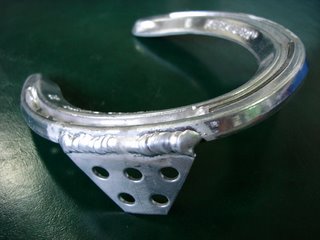
Several people have asked if a particular type of shoe was used on the horses at the Breeders Cup. (see story further down on this blog) The answer is that there were as many shoes as there were horses..or as many different farriers working on them.
From what we hear, Round Pond (winner of the Breeders Cup Distaff, trained by Michael Matz) was wearing race plates with Sigafoos cuffs.
Thoro’Bred Racing Plate Company has a new “Sticky Shoe” that has generated a lot of interest, though I do not know if any horses were wearing it on that particular day. I heard about them from Fred Cleveland, a longtime farrier from Marshall, Virginia. (Fred, by the way, has subscribed to Hoofcare & Lameness since 1986!)
Most farriers start with a standard raceplate and add sometimes tabs over the bars, a la “onions”. Another technique is to add wings, or large clips of perforated aluminum, to increase the glue’s surface area. The Sigafoos cuff is another option.
In this photo, you see a large aluminum clip or “wing” welded to a raceplate. This photo was supplied by Raul Bras DVM of Rood and Riddle Equine Hospital in Lexington, Kentucky.
Tuesday, November 14, 2006
Luwex 2006: The World’s Most Intense Farrier Event?
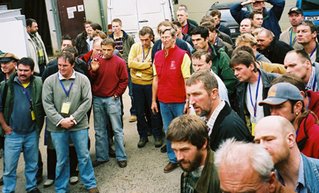
I used to think that farrier competitions were tense, but then I went to Germany and experienced the Luwex Hufsymposium. No competitions at this event (except for a shoeing rig contest that was terrific) but the pressure was on.
Lectures start at 7 a.m. and the last one begins at 10 p.m. I left Mike Savoldi from California still lecturing, however informally, to a dedicated group at midnight in one of the lecture halls.
The marathon shoeing sessions are the focus of the day, as the speakers are put to the test in front of more than 500 farriers from 21 nations. As the cases roll in (and keep rolling in) the speakers evaluate the hooves, shoe them in front of an audience with a camera crew with microphones dangling in their faces, and eager veterinarian translators hanging on their every word. Oh, and an American editor popping off a flash every few seconds. Three shoeing stations are going constantly, with a trade show in the same arena…and a pub, too.
The visiting speakers shoe the horses often without their own tools, in the case of the Americans, and with the use of borrowed, albeit high tech farrier rigs crafted from Mercedes vans. If James Bond needed a farrier rig, he'd probably model his fter Rob Renirie's or Bernard Duvernay's or maybe the super-tall Mercedes of Dieter Krohnert. It would be criminal to leave a scratch, or to have a horse rap one of these rigs with an impatient hoof.
The newly-shod horse is trotted out for all to see…and he’d better be more sound than he was a few hours before. That’s sometimes a tall order for a horse that has been sedated or even just standing around for the hours it can take to get through a demonstration.
Sigi, the Icelandic farrier who did a great demo, took "clinician macho" to a new level when he hopped on his demo horse and headed for the tolting track on the grounds to demonstrate (at high speed) what the horse could do now that his feet were straightened out.
In this photo you see Switzerland’s Bernard Duvernay (red vest, center) anxiously watching his demo horse trot after shoeing. Look at the faces of the farriers in the crowd. If you make a mistake, these guys will remember it. Bernie did just fine.
Bernard divides his time between running a high-tech multi-farrier practice in posh Geneva (where he cruises the lake on a beautifully restored 1920s tug boat) and serving as a farrier education consultant in Third World countries. He might pop up almost anywhere there are horses, but is most often in India. In Germany, he had a young Iranian apprentice visiting him, Ahmad Abad, who turned out to be half-American and a frequent guest here, so you may meet him at an event.
To learn more about Bernie’s important work around the world, visit http://www.farrier.ch
To learn more about the Luwex Symposium, visit
http://www.luwex.de
Hoof Lifting Device Tests Foot Ligaments, Navicular Pain
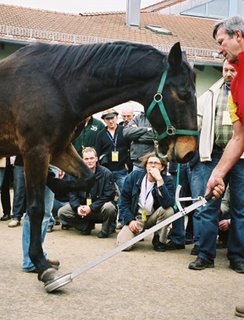

One of the most interesting products demonstrated at the Luwex Hufsympsium in Germany in October was what I called the “hoof lifter”, developed by Italian vet/farrier Hans Castilijns DVM, made in Italy, and demo’d by Swiss farrier Bernard Duvernay.
The horse stands on the device, which is covered with a rubber mat. It looks like that puck-like thing that curlers push around on the ice, with a three-foot handle and a protractor on the end. The operator stands one foot on the device and then stands back and slow raises the angle so that the horse is putting more and more pressure on the back of the foot as the coffin joint flexes.
After observing the horse, the operator than simply swivels the handle, without having to move the horse, and then can raise the lateral side of the device, tipping the foot to the medial side.
Accordingly, without moving the foot, the operator moves to the other side of the horse to test the lateral side.
The Europeans have always been keen on the hoof-lifting coffin-joint flexion tests for navicular pain, and this device gives expanded pain-response capabilities. It is well made and simple to use, but seems to keep the handler safe, too.
Mustad Equilibrium Shoe Debut with Dieter Krohnert at Germany's Luwex Festival
But first, the horse! One of the interesting things about the Luwex event is that they brought back the horses that the speakers had shod the previous year, and they discussed how the horses were doing. He was a mature Hanoverian stallion training at the Grand Prix level.
 |
| Dieter Krohnert, German team farrier |
Dieter said he thought the shoes had been successful the year before but that the horse had not been well cared for and perhaps had gone long periods without trimming. The heel bulbs contracted and thrush or some other bacterial infection had gone up the back of the pastern. The horse had medial quarter cracks in both front feet.
Dieter re-shod the horse with the new Mustad Equilibrium shoes, which are designed for easy breakover across the entire toe surface of the shoe.
 |
| Meike van Heel, researcher |
I think I saw Dieter's hair turn gray right before my eyes but, as always, he kept his cool, shrugged, and said with classic understatement, "See, he's sound now."
For more on the festival, visit http://www.luwex.de
For more about Dieter Krohnert, read "High-End Hoofcare for High-Flying Horses : Dieter Kronhert and Steve Teichman" by Fran Jurga in Hoofcare + Lameness: Journal of Equine Foot Science, Issue 76. (print only) Also search the blog for articles about Dieter.
To learn more about new research, products, and treatments for the horse's hooves and legs as reported to veterinarians and farriers in the award-winning "Hoofcare & Lameness Journal", go to http://www.hoofcare.com
Contact Hoofcare Publishing anytime: tel 978 281 3222 email fran@hoofcare.com
Farrier Truck Competition in Germany
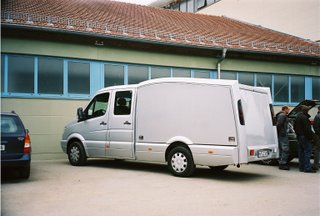
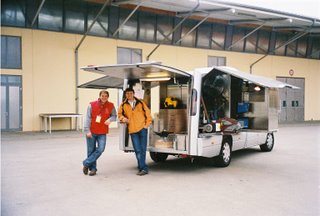 At the education-oriented Luwex Hufsymposium in Krueth, Germany in October, the only competition was for the title of “best rig”. What a collection! One of my favorites was a full cab old-timey Land Rover. Perfect for the farrier who does safari horses. And a homey Mercedes station wagon with a forge in the back. And there were trailers and vans and trucks, oh my.
At the education-oriented Luwex Hufsymposium in Krueth, Germany in October, the only competition was for the title of “best rig”. What a collection! One of my favorites was a full cab old-timey Land Rover. Perfect for the farrier who does safari horses. And a homey Mercedes station wagon with a forge in the back. And there were trailers and vans and trucks, oh my.And then there was The Truck. Loic Entwistle’s new Mercedes custom truck is worth a second look, and a third. It even has a “store” full of horsecare supplies and supplements for customers to buy. It is hidden from view until he pushes a button and it glides out with all the products on display.
Loic is a German farrier and an old friend of Hoofcare & Lameness. He has been a subscriber since 1994. And I think he has been dreaming about this truck even longer!
Also in the photo: Italian veterinarian Lorenzo d`Arpe, who will be a speaker at the Bluegrass Laminitis Symposium in Louisville, KY in January 2007.
Monday, November 13, 2006
Champion Desert Orchid Has Died
(begin quote) Reading The Catcher In The Rye, many Britons nod instinctively when Holden Caulfield remarks: “A horse is at least human, for God’s sake.”
This might explain, to bemused foreigners, why today’s newspapers are so brimming with news of the death of the great steeplechaser Desert Orchid.
Every decade or so, in a process almost as mystical as the emergence of a new pope, the name of a thoroughbred escapes the cloistered world of racetrack bookies, and of punters hunched in betting shops tearing up betting slips scrawled with the names of nags so slow that they were beaten to the finishing line by the groundsman cutting the turf for the next meeting, to become as familiar to the general public as Lester Piggott’s tax returns.
Desert Orchid belonged to this elite stable, which stretches from Arkle — reckoned to be the greatest steeplechaser of all time — through Nijinsky, the last horse to win the English Triple Crown, Red Rum, the only one to win the Grand National three times, Shergar, the kidnapped winner of the 1981 Derby, and the explosively fast Dancing Brave, to Best Mate, the first steeplechaser since Arkle to bag three successive Cheltenham Gold Cup wins.
These are names as well known to most Britons as Silver, the Lone Ranger’s mount, Roy Rogers’ Trigger or Boxer, from Orwell’s Animal Farm.
We have measured out our lives in great horses. There is now a vacancy. (end quote)
Monday, November 06, 2006
"Castaway" Day for Barbaro at New Bolton Center
Barbaro's lower right hind leg had been in a cast since surgery at Penn’s George D. Widener Hospital following his accident at the Preakness on May 20. “He had a perfect pool recovery and immediately stood; he walked easily back to his stall,” said Dr. Richardson. “He used all of his legs quite well.”
Barbaro’s left hind foot, which had laminitis, was also fully evaluated while he was under anesthesia. “There are no signs of new problems with that foot, but the hoof needs several more months of growth before we will know how much foot structure and function will be recovered," said Dr. Richardson.
(This news report was provided by the University of Pennsylvania.)
Sunday, November 05, 2006
Laura Florence Has Left New Bolton Center

Resident farrier and researcher Laura Florence has resigned her post at the University of Pennsylvania’s New Bolton Center after almost five years of service there. Laura reports that she will now pursue a private consulting practice under the name of Holistic Hoofcare, and that she plans to stay in the Philadelphia area.
“(My) impetus is to concentrate more on therapeutic benefits of trimming/barefoot. Though I won't be ruling out shoeing...it will not be a focus,” Florence predicted by email.
An interesting part of Laura’s work has been research on the hoof growth and adaptation of a herd of left-alone ponies at New Bolton Center with behaviorist Dr. Sue McDonnell. Florence’s research will be published soon in Equine Veterinary Journal; watch for the title “Hoof growth and wear of semi-feral ponies during an annual summer 'self-trimming' period”.
Laura's official title was Special Research Fellow of the Dorothy Russell Havemeyer Foundation for 2004–2006. To quote from the UPenn web site: "This appointment supports ongoing research of the hoof growth and natural trim cycle of the semi-feral equid. The goal of the study is to systematically describe equine hoof growth and wear characteristics under natural environmental and social conditions, using the semi-feral herd at New Bolton Center as one model."
Laura also played a key role in the 2nd International Equine Conference on Laminitis and Diseases of the Foot in Palm Beach.
We hope that Laura Florence will continue to provide positive input to Hoofcare & Lameness Journal.
Saturday, November 04, 2006
"Glue-y Ville" Hosts Breeders Cup: Shoes Stay On

Photo: Therapist Diane Volz of Louisville, a subscriber to Hoofcare & Lameness Journal, helped at least 30 of the Breeders Cup entrees with bruised feet, sore backs, aching legs, and anxiety problems during the week leading up to the races. Photo by Fran Jurga, copyright Hoofcare Publishing.
Adrenalin, anyone? Today's Breeders Cup had thrills and spills and the hoof angles (pun intended) are still pouring in. The biggest story seems to be how many horses had their shoes glued on. But there's more...
First, let's talk about Round Pond and her heartwarming win of the Distaff being marred by the tragedy of the death of Pine Island and the breakdown of Fleet Indian. I am sure that those crashes are being replayed on the evening news tonight around the world. Just last May, Round Pond's trainer Michael Matz was watching from the stands at Pimlico when his star horse, Barbaro, stumbled to a halt on the track in front of him, his fetlock dangling.
But today, Matz was back in the winner's circle where he had stood with Barbaro after the colt's dramatic win of the Kentucky Derby in May. And he was looking over his shoulder at the horse ambulance. Did someone call the screenwriters' guild?
But Round Pond has a hoof story. According to the web site allaroundphilly.com, Round Pound sat out nearly five months this year because of hoof problems. Originally thought to be a foot bruise, the injury didn't clear up, so the filly was shipped to the podiatry unit at Rood & Riddle Equine Hospital in Lexington, Kentucky, where she was treated by Hoofcare & Lameness Journal consulting editor Scott Morrison DVM and his staff.
"They figured out that Round Pond has very thinly soled feet, and the nails from a standard shoe tend to pinch her feet," explained Round Pond's owner, Delaware car dealer Rick Porter, in the Philadelphia newspaper article. "The answer was to use glue-on shoes, which she used in the Beldame and will wear for the Breeders' Cup."
To read more about Round Pond's roundabout trip to the Breeders Cup, visit http://www.allaroundphilly.com/site/news.cfm?newsid=17421114&BRD=1671&PAG=461&dept_id=17782&rfi=6
Round Pond, by the way, is a real place; it is one of my favorite little Muscongus Bay towns on the coast of Maine.
Also dipping into the glue were three top horses wearing the Burns Polyflex shoe (http://www.burnspolyflex.com)
The filly Malibu Mint recently set a Polytrack record at Keeneland in Lexington, KY wearing the shoes; she didn't do quite so well against the colts in the Breeders Cup Sprint today. Gary Mandella's Silent Name in the Mile also wore the shoes, as did Brother Derek, trained by Dan Hendricks, who led for about half of the $5 Million Breeders Cup Classic (powered by Dodge) before fading.
Curtis and Diane Burns currently make the wire-cored urethane shoes themselves; scroll down for a more detailed article about the shoes, deeper in this blog; you can also click on the August archive link button in the right hand column.
Brother Derek, by the way, is usually shoeless; Hendricks prefers to train the colt barefoot. He had farrier/inventor Curtis Burns glue the see-through shoes onto the colt before the Goodwood at Santa Anita, where the horse ran second to Lava Man. The horse continued to train in the shoes, shipped east, and ran in them today.
I haven't checked in with my friends Dan Burke from Farrier Product Distribution and Steve Norman, ace shoer at Churchill to see what sorts of special shoes they whipped up, or saw whipped up, but I will update this story when I hear from Dan. He's in Virginia at Danny Ward's big farrier clinic today--along with everyone else in the farrier world!
Not to be outdone by the farriers, Hoofcare & Lameness subscribers Mimi Porter and Diane Volz have been hard at work all week providing therapy to the horses at Churchill. According to a news story on businesswire.com, Diane has used the Equitonic massager on 30 horses bound for the Cup races today. Since she provides therapy for the Todd Pletcher stable, that would be 17 horses right there. I know Diane will be heartbroken by the injury to Pletcher's Fleet Indian, but it sounds like the filly will recover.
AAEP On Call veterinarians Wayne McIlwraith and Larry Bramlage had a busy day. ESPN seemed to keep a bit more distance from the tragedy than the network sports broadcast team at the Preakness.
(An amazing fact from today's races is that trainer Todd Pletcher sent out 17 horses and did not win a single race. But he scored enough placings to take home almost $2 million in purse money, according to the Louisville Courier-Journal. Without winning a race. Think about it.)
Finally, the day ended with South American superstar Invasor running down the favorite Bernardini. I don't know what that horse had on his feet, but they worked just fine. I know a little bit about Invasor. Every time I saw him at Saratoga this summer he was sulking in his stall, but his existence here is thanks to Hoofcare & Lameness friend Hassan bin Ali, endurance racing trainer for Sheik Hamdan al Maktoum, and a former bloodstock agent for Sheik Hamdan's Shadwell Stud.
Hassan, who is an avid follower of shoeing technology innovations, popped in here one day last August in the middle of a heat wave, which was like a cold day in Dubai. He showed me videos on his cell phone and camera; he came here straight from Uruguay, where he had been buying endurance horses. To show off the sale horses, they galloped them on a paved road for miles, with Hassan following in a car with the windshield wipers flapping back and forth. It was quite a video.
I made a comment about road founder and he laughed. "Oh, and I bought a racehorse, too, while I was down there," he added nonchalantly. "The champion of Uruguay. I think maybe he will win the Breeders Cup."
The next time I saw Hassan was in the winner's circle after the Whitney at Saratoga. And today his impulse buy for the Sheikh won not just a Breeders Cup race, but THE Breeders Cup race, the Classic.
One of the saddest things about the end of the Breeders Cup, after the death of Pine Island, is that so many of the horses will not ship back to Belmont and Santa Anita, or even to Florida. They'll just take a 90-minute van ride to Lexington and their racing shoes will be pulled off forever as they start new careers in the breeding shed and broodmare band.
It was great to see older horse Better Talk Now charge up to second place in the Turf; sadly, 7-year-old Perfect Drift didn't do much in the Classic.
I'd like give a big thanks to all of the horses, and to the people who have worked so hard all year to keep them sound. This year had many fewer horses lost in the final weeks because of foot lameness. Is it the glue? Is it training on the Polytrack at Keeneland? Was it the wet summer up here in the North? I don't know, but racing has been great fun to follow this year, and the fact that they all have four feet means that the odds of me finding a story to tell are probably better than that I will ever cash a winning ticket.
And I wouldn't have it any other way.
Readers: if you have hoof-related stories from today's Breeders Cup, please send an email to fran@hoofcare.com and I'll share it!
This and all content on the Hoof Blog copyright 2006 Hoofcare Publishing. No use without permission. The Hoof Blog is created by Fran Jurga as an adjunct to Hoofcare & Lameness: Journal of Equine Foot Science. . For more information or to subscribe, please visit www.hoofcare.com or call 978 281 3222 in the USA.
Natural Balance Farrier School to Open in New England in 2007
In an interview with Hoofcare & Lameness on November 3rd, Solman said that the course will have three modules: two weeks of trimming, four weeks of shoeing, and four weeks of advanced shoeing. Bob was one of the first group of farriers to pass the new Natural Balance certification testing process this summer.
While Bob says that the program has been approved, the college's web site says it is looking for horses for the students to shoe.
Keep an eye on http://www.nmcc.edu/farrier.php for more details.
Friday, November 03, 2006
French Researchers Study the Egg Bar Shoe
Professor Jean-Marie Denoix of France has long been a stickler about the use of egg bars depending on if the horse is laid up or competing and, if competing or turned out, what surface the horse is working on.
We now have a new report from the vet school at Alfort in Paris, conducted by Denoix, with Henry Chateau and Christine Degueurce. They took the egg bar out of the hard force-plate track, which is how the shoe was tested by Alan Wilson's Motion and Locomotion Laboratory at the Royal Veterinary College in England. The French group tested it in sand.
Alas, the report does not specify if steel or aluminum was used, and what the thickness and width of the bar was. We will try to obtain that information. It is also not known if they measured both front and hind effects of egg bars. The data published is only on the front feet.
They used four sound horses and found that, compared to normal shoes, the heels really did sink less into the sand with the egg bars and that the horses' heels were raised at mid-stance phase, compared to plain shoes. Maximal flexion of the coffin and pastern joints was increased and extension of the coffin joint at heel-off (aka "breakover") was reduced.
In three-dimensional analysis, the egg bar affected the medial quarter's sinking into the ground.
Based on these findings, Denoix's group felt justified in recommending egg bar shoes for horses working in soft footing who might benefit from these changes in joint angles or who would work better moving more "over" than "into" soft footing.
AAEP Update from Dr. Steve O'Grady

Here's some additional information from Dr. Steve O'Grady, who has been organizing the farrier conference at the upcoming AAEP Convention in San Antonio, Texas. Dr. O'Grady writes:
"The foot topics will kick off on Sunday afternoon December 3, 2006 with 3 X one and one half hour table topics. These are sessions on a given topic with two facilitators where a discussion is generated among the attendes.
"I will facilitate one on barefoot versus shod with Dr Dan Marks. This is a very controversial subject which will no doubt stimulate debate especially with farriers present.
"Two well veterinarians, Kent Carter and Tracy Turner will direct a session on foot lameness which always turns out to be a learning experience.
"Finally, Bill Moyer and well known farrier Rob Sigafoos will man a session on the management of various hoof wall defects. These two practitioners have a world of experience on crack repair.
"I will post highlights of the upcoming convention periodically in the near future. It should be a great experience for all."
--Steve O'Grady
Stranded Dutch Horses Rescue on BBC Site

Here's a link to some great stills and a video clip of the rescue of 100 horses stranded in floodwaters in Holland. I was stranded there myself, albeit in the comfort of the airport, earlier this week.
http://news.bbc.co.uk/1/hi/in_pictures/6114596.stm
Link to a Great Article!

Everyone in the realm of Hoofcare & Lameness knows Michael Wildenstein, farrier at Cornell University's College of Veterinary Medicine. Mike is a consulting editor here at the magazine and a great friend. He'll be hosting Cornell's highly-regarded farrier conference next weekend at the large animal hospital, which will attract farriers from all over the country.
Cornell posted a nice story and photos about Mike today on their site; here's the link:
http://www.news.cornell.edu/stories/Nov06/Wildenstein.profile.jg.html
Photo by Jason Koski/University Photo.
Thursday, November 02, 2006
New Research: Raising Heels on Front vs. Hind Feet Have Different Effects
At the recent International Conference on Equine Exercise Physiology (ICEEP) held in Fontainebleu, France in August 2006, researchers Girtler, Licka, Kicker, and Peham walked around to the back end of the horse to compare their colleagues' research findings from the front end.
They evaluated the horses barefoot, then added a 2 cm and finally a 4 cm wedge to the hind feet and worked the horses at a walk and a trot on a treadmill, with 8 markers per limb and 15 cycles per effort, per horse.
Among their findings: the angle of the coffin joint changed significantly between the walk and the trot; raising the heels increased the angle more at the walk than at the trot. Fetlock extension in the mid-stance phase was reduced when the wedges were added.
They concluded: "Raised heels decrease hind fetlock extension, which is different to the effect of raised heels on the fore fetlock. Additionally, raised heels led to a significant reduction of hock extension during stance phase at walk and trot, supporting the reported positive influence of raised heels in horses with spavin."
Wednesday, November 01, 2006
Good-bye to Cal Chilton
It just won't be the same without you, Cal. Good luck and stay in touch!


